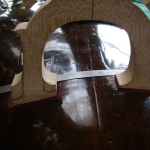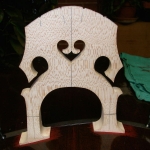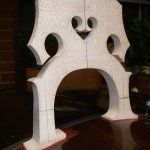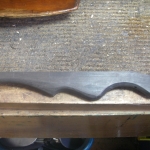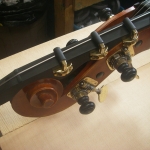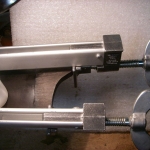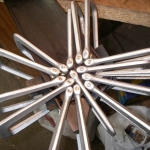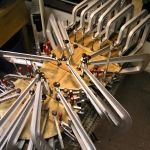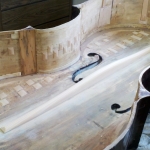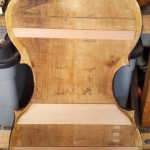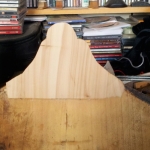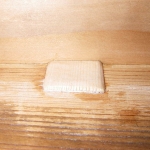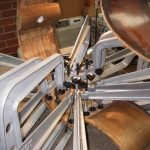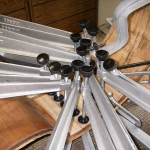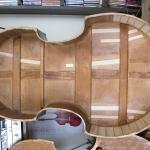Proper set-up, routine repairs and restorations—regardless of how extensive—are the core of my business. This is what I enjoy most about my daily work. The reputation of my business is built upon the highest quality set-up work, whether fitting a new soundpost, cutting a bridge, making a new fingerboard, or dressing an existing fingerboard. Every single day that I enter my workshop, I put the entire financial future of the business at the mercy of satisfying customers’ desires to have their instrument in the best possible working order. Whether you are a student, teacher, free-lance musician, or a longtime member of a symphony or opera orchestra, I will deliver the best quality work possible in order to help you achieve your musical goals, regardless of genre!
Here you will find various photos taken over the years of examples of repairs and restorations in process. Some are routinely encountered, while others are less common, but all of these procedures must be done in the best manner possible to ensure the long-term stability and acoustical integrity of the instrument. What the photos cannot show is the “creative thinking” process that happens while planning the procedures, prior to starting any repair or restoration. As is often the case with double-basses, there will be previous work that was poorly executed. Newer and older instruments present different challenges as many makers from centuries past were not so concerned about symmetry or “square”. The large physical size of the double-bass leads to more seasonal movement of wood due to changes in humidity throughout the year. All of this must be taken into consideration when commencing with the repair and restoration of an instrument, old or new.
SET-UP & ADJUSTMENT
The proper set-up and adjustment of a double-bass is vital to playability, comfort, and acoustic response. Set-up can include but is not limited to: fingerboard shape, depth of “scoop”, proper thickness, end-of-fingerboard arching, well dressed fingerboard, proper string height and spacing at the top-nut, properly fitted and placed soundpost, appropriate diameter of the soundpost, properly fitted and placed bridge, appropriate thickness of the bridge, proper string spacing on the bridge, correct bridge arching, string-to-string height as measured from the fingerboard, functionality of the endpin, type of tailpiece wire or rope, tailpiece length, tailpiece weight, functionality of tuning machines, or simply a fresh set of strings. Set-up may entail only one of these items or it may encompass the whole list.
LOW C-EXTENSIONS
Access to notes down to a low C on the double-bass is a necessity for orchestral players and has been used to great effect by some jazz players. Less common, but also seen on occasion, is the low B-extension (such as needed in Respighi’s “The Pines of Rome”). Since 5-string double-basses are not as commonly seen in the USA, low C-extensions are used. The extensions are made of ebony. For the toggles, I use bronze metal toggles or acetal toggles, a homopolymer resin that has high stiffness and strength with no shrinkage. Additionally, the mechanical Stenholm variety of extensions can be fitted and adjusted, as well as fitting toggles on an already existing extension. When making a new extension, I will NEVER cut into an existing scroll, instead fitting the ebony extension to the concave surface of the volute on the scroll.
Low C-extension with one toggle at the “E”: $1,500
Low C-extension, fully chromatic: $2,500
Low B-extension: $2,750
Mechanical “Stenholm” extension: please inquire
Fitting toggles to an already existing extension: $250 per toggle
Photos of Low C Extensions (Bronze Metal Toggles):
Photos of Low C Extensions (Machined Ebony or Delrin Toggles):
NECK & SCROLL REPAIRS
Repairs to the neck and scroll can include repairing of broken scroll/pegbox/volute, making a new fingerboard, resetting a neck due to damage or improper angles of the original neck set, pinning of a broken neck, grafting an original scroll onto a new neck, adding to the length at the end of the fingerboard so as to allow for more notes “over wood”. Although somewhat rare, pegbox flank facing is also undertaken, often due to damage and disfigurement from multiple previous tuning machines, overlapping bushings of previous tuner peg holes, or even worm damage to the wood.
TOP & BACK REPAIRS
Repairs to the top and back of the double-bass can be numerous, depending on the damage. Sometimes older instruments lose their original arching and become deformed after decades or centuries of string tension on the top of the instrument. Center seams can open up due to changes in humidity or wood movement over the life of the instrument. Possible repairs can include any of the following: correction of sunken arching, crack repair in the top and/or the back, rejoining a center seam, doubling of the button or even grafting a new button, replacement of a bass bar due to a neighboring crack, replacement of corners, doubling of the edge of the top or back, replacing the edge of the top or back, chest patches, soundpost patch, repair of worm damage, even conservatively re-graduating an overly thick top or back. Due to movement of wood over time, the cross bracing in flat-backed double-basses also at times must be replaced.
Barbe-pere double-bass, circa 1820:
Camillo Camilli double-bass, circa 1730:
Clamping loose back braces, back off:
Complete edge doubling, top off:
Northern Italian double-bass, circa 1760:
Venetian attributed double-bass, circa 1780:
RIB REPAIRS
Once the top has been safely removed from the instrument, it is often advisable to take care of any other damage or needed repairs to the ribs as well. Wood becomes brittle over time and great care must be taken not only in the everyday handling of older instruments, but also when repairing or restoring them. Cracks can occur either with the grain or across the grain—more often seen in flamed wood, thus called a “flame crack” or “crossgrain crack”. Rib cracks at the neck block or the endpin block are a sign of shrinkage and tension. The thickness of a double-bass rib is about 2.5-3mm. Ribs often warp over time, and thus more challenging when fitting cleats over cracks. Aged willow works very well for rib repairs and doubling, allowing for an overall better fit. If a rib has multiple cracks in one area, it is better to make a full-length cross-grain cleat, essentially doubling that area of the rib. A willow cleat used in rib repair weighs not more than 2 grams, and usually less than 1 gram, adding the least amount of mass possible to the instrument when repairing the ribs. Willow has an interwoven grain fiber that gives it maximum strength with minimal weight. This is why it is used in Cricket bats and also traditional wooden shoes in Europe! Aged spruce is used for crossgrain cleats on any crack in the top. I have a large supply of well-aged, dried wood specifically for use in repairs and restorations.
COUNTER FORMS – CASTS AND MOLDS
Making a gypsum cast or mold is something that is often done prior to edge doubling, button doubling, new button grafting, arching correction, fitting a new upper or lower block, or fitting a new bass bar. Normally, I use gypsum, adding wire screening as a rebar material. All parts of instrument are properly protected when a mold is being made. Since gypsum produces heat when it begins to set, this stage of the process is closely monitored. Once the plaster cast has been safely removed from the instrument, it must dry thoroughly prior to use. The plaster cast is then used as a clamping caul when fitting a new block, repairing a rib corner, when doubling an edge to insure that all worked surfaces are on the same plane, precise fitting of a bass bar, or whatever other repair in which it might be used. With small instruments, such as the violin, it is often beneficial to make a wooden counterform carved out of basswood, also called “linden”, “tilia”, or in the UK, “limewood”. Once again, the sheer size of the double-bass makes this not financially feasible for either the restorer or the client!
